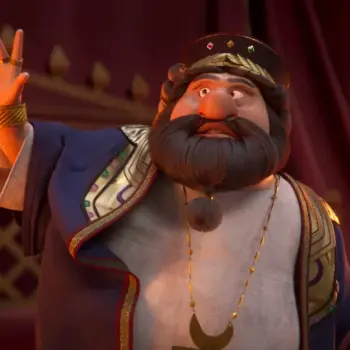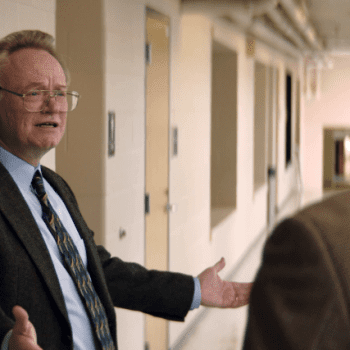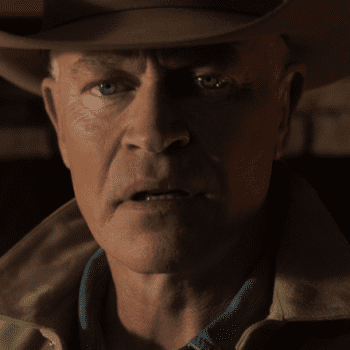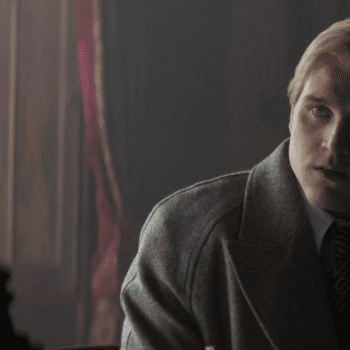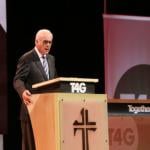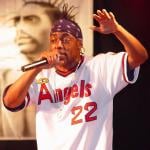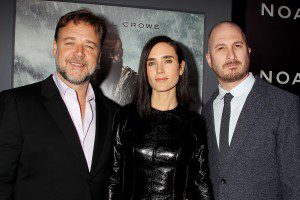 When I interviewed Darren Aronofsky in New York four weeks ago, it was the first time I had heard him discuss his film Noah in the context of midrash, a form of Jewish narrative interpretation of the scriptures. But he has certainly brought it up quite a bit in the interviews he has done since then.
When I interviewed Darren Aronofsky in New York four weeks ago, it was the first time I had heard him discuss his film Noah in the context of midrash, a form of Jewish narrative interpretation of the scriptures. But he has certainly brought it up quite a bit in the interviews he has done since then.
For example, it’s right there in the headline that sits atop the interview that Huffington Post religion editor Paul Brandeis Raushenbush did with Aronofsky and his co-writer Ari Handel (‘Noah: A Midrash by Darren Aronofsky and Ari Handel’). A couple sample quotes:
Paul: I love the idea of Noah, the movie, as midrash, you really studied the text?
Ari: We tried to read everything and talk to everything we could for guidance. Ultimately in the midrash tradition the text has purposeful lacuna; it has questions that are posed in the very words, so the closer we read it, the more questions arose from it. . . .
Paul: What is the role of the apocalypse in your thinking of Noah? Did you look at apocalyptic or end-times literature?
Darren: Not as much. The apocalyptic nature of the story is right on the top. We went more to the midrash when we were trying to get underneath. The apocalypse is the story on the face of it — it is the destruction of everything.
Aronofsky also reveals that he and Handel thought about making Noah a descendant of Cain’s, because the genealogies of Cain (in Genesis 4) and Noah’s ancestor Seth (in Genesis 5) have so many names in common. But, much to the relief of this Bible-geneaology buff, they decided to “honor the text” instead.
The subject of midrash also comes up in an interview that Aronofsky did with my friend Steven D. Greydanus for The National Catholic Register:
You find really interesting ideas in rabbinic texts. There’s the word sohar [in Genesis 6:16], which rabbinic scholars have thought about for a long time. Some said it refers to a window; others have talked about this magic stone that glowed brighter during the day and darker at night. So we decided to follow the magical-stone idea, because it kind of fit into this idea that the antediluvian world was somehow different from today. It helped us build this fantastic world that was so close to creation. It was a different time from now. . . .
And there’s that midrash where they talk about the idea that the world was destroyed many times before. So there’s the idea that the Noah story is not the first apocalypse — that God had actually reset the world before.
The subject of midrash also comes up briefly in The Jewish Journal, though it is not elaborated on very much there. Handel does offer one interesting quote, though, on the relationship between Noah’s righteousness and his darker side:
“Anyone would react harshly to witnessing the destruction of everything. Noah is said to be a righteous man, so to resist the human impulse to save [everyone] takes a lot of will and energy, and it’s very painful. You’re going to have a kind of hangover from that.”
Turning to other interviews that don’t mention midrash, Aronofsky revealed to Cathleen Falsani of The Atlantic that his interest in the Noah story actually goes back even further than the poem that he’s talked about before:
I’m always talking about the poem I wrote when I was 13. But just last week, I was talking to my co-writer, and I kind of had a flash of a memory before that that I can’t place. I remember the feeling of being afraid, of terror. And I think hearing the story of Noah, I thought about, What if I was not one of the good ones to get on the boat? And I recognized that there’s wickedness in all of us. . . .
So, why go through this? What is the reason for it? To me, that’s what’s powerful about it. It’s meant as a lesson. It’s poetry that paints images about the second chance we’ve been given, that even though we have original sin and even though God’s acts are justified, He found mercy. There is punishment for what you do, but we have just kind of inherited this second chance. What are we going to do with it?
Discussing our stewardship of creation, Aronofsky also notes:
Leviticus, also in the Bible, talks about how every seventh year we’re supposed to give the land a rest. When’s the last time our land has gotten a rest? We’re way overdue for that jubilee. And I think that’s what I want. That’s why I made the film. For that reason.
Sarah Pulliam Bailey of Religion News Service also spoke to Aronofsky:
Q: If I were to guess which scene would make some people uncomfortable (without revealing spoilers), it seems like there’s a part where Noah appears to be in almost direct disobedience to God.
A: All of it’s a test. We were trying to dramatize the decision God must have made when he decided to destroy all of humanity. At the beginning of the Noah story, everything is wicked and God wants to start over. The pain of that, the struggle of that, must have been immense. To basically go from creating this beautiful thing to watching it fall apart, and then doing this horrible thing where you have to try and start again.
So we tried to take that huge cosmic idea and put it into a human’s hands. That’s what Noah’s story is. If you think about that moment, when God looks at the wickedness, it grieved him to his heart. We wanted to get that grief, that struggle, and stick it into Noah, so we can understand as people what it must have felt like. What would hurt more than to do — in vague terms — what Noah is about to do? Which for us was an exact metaphor for what the decision was, what the Creator went through. But he chose love! He chose mercy, which for us is the exact same story as the story in the Bible, just put into human terms.
Speaking of the poem Aronofsky wrote when he was 12 or 13, he quotes part of it in the interview posted by Matt Joseph of We Got This Covered:
“I actually just had it scanned and sent to me,” replied the director when we asked about the poem that inspired the film. “Let me read you some of it.” Opening it up on his phone, he started reading, “evil is hard to end and peace is hard to begin, but the rainbow and the dove will always live within every man’s heart…..It goes on but it’s a little embarrassing,” said Darren with a laugh.
Aronofsky also discusses how the studio has been downplaying the Watchers or Nephilim and similar “fantastical” elements in its marketing — and he notes that the religious audience members might actually be into that stuff more than the non-religious ones:
“The religious people really dig it, they love it,” exclaimed Darren. “It’s the most bizarre thing,” he said with a laugh. ”I think it’s the more general audiences that will have a problem with this stuff. Russell Crowe is so real, and the film is so real. You feel the wind and you feel the nature. Then suddenly these strange things appear and it might take people a while to get into them.”
Turning to non-print interviews, in an audio interview with EURweb, Aronofsky talks about how his efforts to make the story more “human” are more clearly rooted in the Bible than certain other people’s attempts to make the story “human”:
See also his phone interviews with Jeffrey Wells and Jian Ghomeshi of CBC Radio.
Drew McWeeny at HitFix begins his interview by asking about the creation/evolution sequence, and Aronofsky ends up discussing the possibility that the story might take place in our future rather than our past (with another nod to, yes, midrash):
By far the dumbest controversy that has come up in connection with this film is the one based on the (false) assertion that the script never uses the word “God”. Aronofsky addresses that in this interview with Fox 5:
Finally, PETA posted this video in which Aronofsky explains the moral and technical reasons for using digital animals in films like his rather than real ones:
http://www.youtube.com/watch?v=pv28hTHGYGY
The film had its New York premiere last night — that’s where the photo at the top of this blog post comes from — and it opens in theatres tonight. So it’s basically here now. But I may post more interview round-ups later.
Update: Movieguide also posted this interview with Aronofsky and Russell Crowe:
Aronofsky and Crowe also spoke to ABC News for this story:
March 28 update: Today MTV News posted this interview with Aronofsky:
March 29 update: Aronofsky made a point on The Colbert Report that I haven’t seen him make elsewhere yet, to the effect that the Hebrew word for God’s messages to Noah indicates that he would have used dreams rather than spoken words:
Aronofsky also appeared on Good Morning America yesterday:
Aronofsky also spoke with National Public Radio; in that interview, he mentions that the definition of a “cubit” varies from culture to culture, so he told his production designer to use the largest cubit to give the Ark a Hollywood sense of scale.
Aronofsky also spoke to CBS This Morning today:
March 31 update: Aronofsky also spoke to Josh Horowitz for his half-hour podcast Happy Sad Confused, which is downloadable via MTV News.
Aronofsky also spoke to Canadian TV host George Stroumboulopoulos:
April 1 update: Aronofsky talks to Christiane Amanpour at CNN:
April 2 update: Aronofsky and Jennifer Connelly spoke to Robbie Collin at The Telegraph; one of the things Aronofsky reveals is that Connelly, who had worked with him before, was the only actor he had in mind as he was writing the script:
April 4 update: The Daily Telegraph, via The Ottawa Citizen, has a text version of Collin’s interview with Aronofsky:
“The problems arose because the studio were trying to serve religious literalists,” says Aronofsky. “Because there is a big part of the population in America who don’t want anything to contradict their view of the Bible, and they are never going to be open to this type of interpretation.”
For him, the Noah story is something metaphorical and mythic, a beautiful fiction that points towards truth, rather than simply reporting it.
“To argue about it as if it was a historical event is ridiculous. Which, by the way, goes for atheists, too – the people who do the math and say, ‘Well, all of the animal kingdom couldn’t fit into one boat.’ The whole conversation is ridiculous.” . . .
These narrative curlicues have already caused no small amount of upset: only last week, the strident American Creationist Ken Ham wrote in Time magazine that the film was “pagan” and “unbiblical”. (He also complained that the ark “did not look seaworthy”.) But Aronofsky – who is not a believer, calling himself a humanist rather than an atheist – seems broadly unworried.
“I’m not interested in these people,” he says. “Of course I’m going to be their enemy – I made Black Swan and The Wrestler. I don’t even know how to talk to someone who believes the world was created in six days and does not accept that could be poetry.” . . .
Instead, he wanted to capture his own childhood reaction to the Noah story: one that was equal parts wonder and horror. (He describes his family background as “culturally Jewish”.)
“I recognised I was not such a good kid, and felt guilty about it, so how could I get on the boat?” he says. “I found the story scary because I sympathised with everyone who drowned.”
Aronofsky also spoke to GQ magazine:
You’ve worked once again with Clint Mansell on the score. Was there a particular record he referenced when discussing the soundtrack?
He was listening to a lot of different stuff. Really we wanted to do something fresh and new. Normally when you do a big epic, you’d use all this big, orchestral sounds, but we aimed for dissonance. We got a 120 piece orchestra, but we got them doing stuff they’ve never done before and playing in ways they never had. In the end we came up with a really great sound for the movie. . . .Vanity Fair talked about Noah wearing an “infinity scarf” and carrying a manbag. But which one item should no man have in his wardrobe?
We really wanted the costumes in Noah to be timeless. We didn’t want to see the old man with the white beard and the robe and the sandals. I wanted it to look like it was from either deep in the future, or a long, long time ago, in a galaxy far away. We really wanted to work that ambiguity in. Michael Wilson is a great costume designer; he just got nominated for an Oscar for American Hustle. He breathed incredible life into this ambiguous place where you couldn’t really understand where the fabrics were from. In terms of what a man shouldn’t have in his wardrobe, I’m not too much of a fan of the little handkerchief’s people wear in their pockets. But who knows, they might go away. I think fashion comes round in cycles. . . .When was the last time you were starstruck?
When I met the Pope and the Dalai Lama. Those are the big ones, but they’re beyond celebrity. They didn’t give me any direct advice, but everything that comes out of their mouths is interesting. Also, every time I see Jared Leto, he gets bigger and bigger and I get more and more starstruck.
Aronofsky also spoke to Religion & Ethics Newsweekly on PBS for their story about the Bible movies that came out in the first part of this year:
April 6 update: Aronofsky spoke to Kim Masters for her podcast The Business.
April 15 update: Aronofsky discussed the shooting of Noah’s first confrontation with Tubal-Cain for Yahoo! Movies’ ‘Instant Commentary’ series:
Aronofsky also spoke to the British website HeyUGuys and said literalists “don’t deserve” the Noah story because they “miss the point” of it:
April 23 update: Aronofsky and Handel took part in a panel on “the Nexus of Faith and Environmentalism” at the Center for American Progress (via Mother Jones):
http://www.youtube.com/watch?v=_K2dHvtcF5g
May 6 update: Aronofsky and Handel were also interviewed by Andrew C. Revkin for The New York Times’ ‘Cities for Tomorrow’ event on April 22:
August 6 update: Aronofsky took part in a panel discussion on ‘Movies in Your Brain: The Science of Cinematic Perception’ on July 30. In this excerpt, he discusses the “pan-cultural” nature of myth and the value of tragedy:
August 29 update: Aronofsky discussed the environmental themes in Noah with a couple websites after visiting the Athabasca oil sands, a.k.a. the Alberta tar sands, which he said were “a big influence on the visual look of the prediluvian world.”



